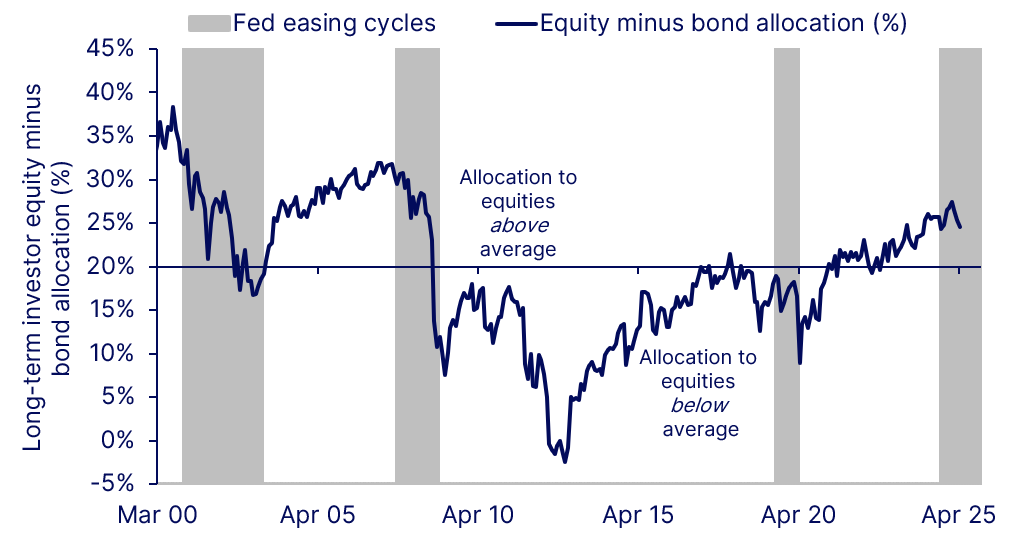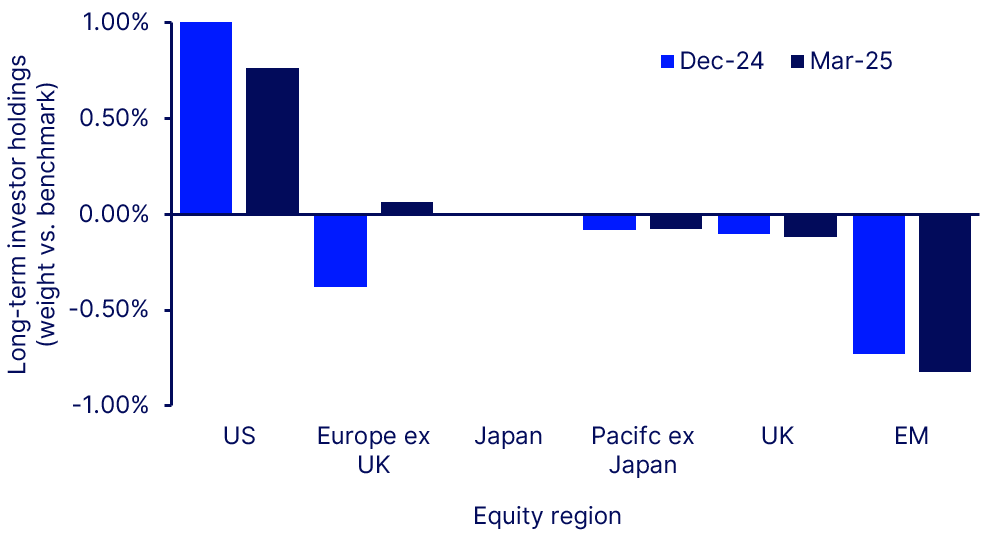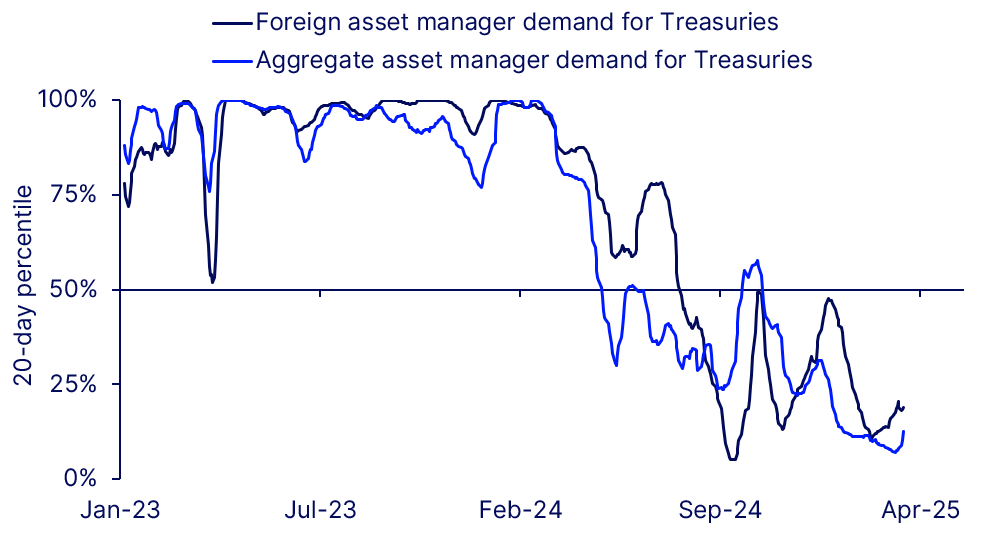April 11, 2025
What to Watch
Complimentary CONTENT
Market shifts have shifted, what’s next?
By: Michael Metcalfe
Summary
In our 2025
market outlook, we identified the pressing questions that would shape global
financial markets this year; would investors remain overweight equities, could
the US remain exceptional and was there trouble ahead for the US dollar to name
a few.
In just three months, the market’s conviction, as captured
in concentrated positions in risk and US assets, has quickly evaporated in the
face of policy and economic uncertainty. But as we move into the second quarter,
we return to our original questions and using State Street’s metrics of
investor behavior, assess whether the dramatic market adjustments mark a bottom
or are the start of a longer-term adjustment process.
Will investors remain overweight equities in 2025?
Investors came into 2025 with an extended overweight position
in equities. Over the past 25-years, the average allocation to equities has sat
around 20% above investors’ allocation to fixed income (in keeping with the
60/40 portfolio). In January, the equity allocation stood at 27% above fixed
income, a fifteen year high. As we noted in January, given allocations to
equities relative to bonds typically fall during Fed easing cycles, this overweight
position represented a potential vulnerability for asset markets. A
vulnerability that has been realized as policy and economic uncertainty has
risen sharply in the first quarter. In response, investors have rapidly reduced
their allocation to equities, but from historically high levels. And given the
sheer size of the overweight position in equities, the reduction through early
April has resulted in the allocation to equities relative to bonds falling from
27% to 25% (Figure 1). So asset managers still have some way to get back to a
benchmark allocation of equities should uncertainty and cyclical news get worse
from here.
Figure 1: Equity
vs. bond allocations, still elevated

Source: State Street Global Markets
2. Can the US remain exceptional?
Asset managers began to reduce their significant overweight position
in US equities in the closing months of 2024, but still came into the year
broadly positioned for US exceptionalism. A view that has been challenged so
far in 2025. The overweight in US
equities has fallen by around a third and now stands at its lowest level in
three years (Figure 2). European equities have been the prime beneficiary of
this as investors eliminated their underweight in the region’s equities and
have begun to build an overweight. While this overweight in aggregate remains
modest, it is very uneven on a sector basis and our data suggests that by the
end of Q1 investors now have larger active overweight in European banks than
they do in US tech.
The bottom line is that investors are still positioned for
US outperformance, but their conviction in the idea is at a three year low. We
now await whether relative fundamentals will encourage investors to remain
overweight US or rebalance further in 2025 and begin to eliminate their still
substantial underweight in emerging market equities, which remains larger than
where it began the year.
Figure 2: Investors
equity allocations across regions, a little less US centric

Source: State Street Global Markets
3. Is there trouble ahead for Treasuries?
Asset manager demand for US Treasuries has been both a
source of hope and potential risk for some time. In December 2023, the
resiliency of asset manager demand for Treasuries was one our seven
surprises for 2024. In the end, that resiliency held for much of the year.
But asset manager demand for Treasuries and duration in particular ended the
year timidly and what was previously resilience now remains a potential risk
for 2025.
In aggregate and on a duration weighted basis, demand for
Treasuries has been in the bottom quartile of observations seen over the
past-five years for much of the first quarter. As of early April, reduced
growth expectations and the weakness in equity markets have not resulted in a
recovery in demand for Treasuries, particularly long-dated Treasuries. This
will prove an interesting test in Q2 and the remainder of the year as to
whether potential impediments to inflows into Treasuries, from concerns about
future inflation or future deficits, can be allayed or more fully offset by
weaker economic news. Here our real-time inflation data from PriceStats will,
at least, give us a timely read on how quickly (or not) actual tariffs or even
the looming threat of them is impacting price formation.
Figure 3: Asset
manager demand for Treasuries

Source: State Street Global Markets
4. Will the US dollar strength persist?
In a similar vein to US equities, asset managers began 2025
with a significant overweight in the US dollar. This overweight took many
different forms, but was best demonstrated in changes in observed hedging
activity of asset managers (Figure 4).
For fixed income managers based in the US, the fear of a
rapid USD appreciation following the US Presidential election manifested itself
in a surge in forward USD buying that took their hedge ratio on their foreign
bond holdings to a peak of near 80%, a 25-year high. This ratio peaked in
mid-January and as the feared US dollar overshoot failed to materialize, US
managers sold their US dollar forward rapidly to bring their hedge ratio back
down below 60% and close to its long-term average. This part of the US dollar
unwind would seem therefore to be done.
However, not all investors have adjusted to the
US dollar’s weaker trend. Non-US investor hedge ratios on their US equity
holdings remain unusually low. This means that for all the foreign buying of US
equities in the past five-years, there have been relatively more forward sales
of the US dollar to offset the currency risk. This is understandable as
typically during this period the US dollar has offered a natural hedge to
equities. Generally when equities have declined, the US dollar has appreciated
given its empirical safe-haven status. But this relationship has been
challenged so far in 2025.As investors
have reduced their US asset holdings, the US dollar has depreciated alongside
equity market declines. This may challenge the view that non-US investors
should maintain such a low hedge ratio on their US equity exposures and is one
area we will watch closely in Q2 for a potential continuation of forward US
dollar sales from asset managers.
Generally when equities have declined, the US dollar has appreciated given its empirical safe-haven status. But this relationship has been challenged so far in 2025. As investors have reduced their US asset holdings, the US dollar has depreciated alongside equity market declines. This may challenge the view that non-US investors should maintain such a low hedge ratio on their US equity exposures and is one area we will watch closely in Q2 for a potential continuation of forward US dollar sales from asset managers.
Figure
4: Changing
attitudes to the US dollar

Source: State Street Global Markets
Q2 and beyond
In response to the unprecedented uncertainty about policy
and the economic outlook, investors have reduced their exposures to risky
assets. But as of the first week in April, holdings of equities in aggregate
and US equities in particular remain above benchmarks and long-term historical
averages. To that end, they remain vulnerable to further position unwinds
should escalations in the trade war or recession risks grow in the coming
months. At the same time, we are watching carefully how asset manager demand
for Treasuries evolves in light of concerns surrounding fiscal deficits and
inflation expectations.
Finally, and in a departure from post COVID trends, asset
managers have also reduced their US dollar holdings, as they have reduced their
risk appetite. Having begun the year with a significant overweight in the
currency, asset managers begin Q2 with US dollar holdings close to neutral levels.
But we note that non-resident investors still have unusually low hedge ratios
on their US equity holdings, which may prompt further US dollar selling in Q2
if the usually reliable link between the US dollar and equity performance
continues to be questioned.
Disclaimer & Risk
Author Bios

Michael Metcalfe
Michael is Senior Managing Director and Head of Macro Strategy at State Street Markets
The information provided herein is not intended to suggest or recommend any investment or investment strategy, does not constitute investment advice, does not constitute investment research and is not a solicitation to buy or sell securities. It does not take into account any investor's particular investment objectives, strategies or tax status. Past performance is no guarantee of future results. For more information, please see the link for the marketing disclaimer for State Street Markets research, available in the “Legal Disclosure” section of our “Disclosures” page referenced in the footer below.